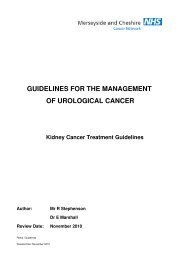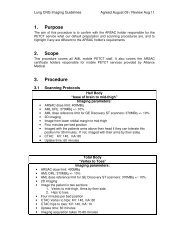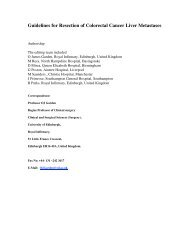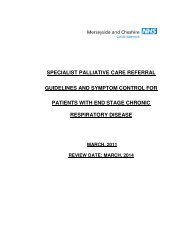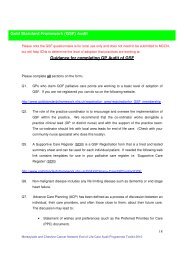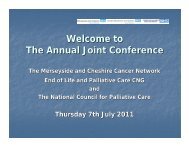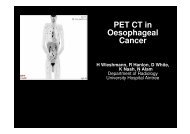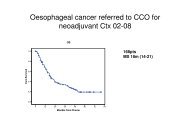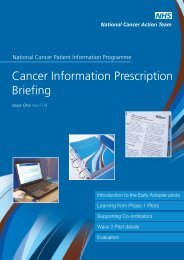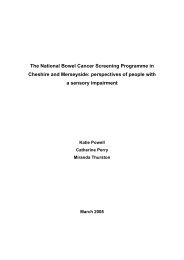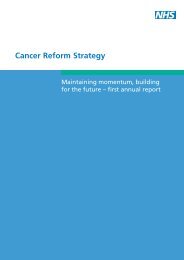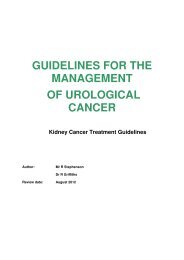Cancer Reform Strategy - NHS Cancer Screening Programmes
Cancer Reform Strategy - NHS Cancer Screening Programmes
Cancer Reform Strategy - NHS Cancer Screening Programmes
- No tags were found...
Create successful ePaper yourself
Turn your PDF publications into a flip-book with our unique Google optimized e-Paper software.
CHAPTER 5: LIVING WITH AND BEYOND CANCER 75Box 28: Informed decision makingShared decision-making about treatment options is important, but not widely practised in clinicalcare. Patient decision aids have been shown to increase patients’ knowledge, involvement indecision-making and preventative behaviour and they lead to more appropriate use of tests andtreatment. In some circumstances they have also been shown to improve cost effectiveness byreducing the use of unnecessary or unwanted interventions (Picker Institute).The Urology Informed Decision Making project has been piloting the implementation of decisionaids for early stage prostate cancer into routine practice in the <strong>NHS</strong> since 2004. Phase I was pilotedusing US materials in four hospitals and the findings have been fed into Phase II which is beingpiloted in six further sites. This phase of the project is developing patient booklets and DVDssuitable for UK practice, along with delivering staff training workshops and staff training DVDs.The project is due to rollout the materials from April 2008 using established cancer networks.Some good practice models exist of how peoplewith cancer can be involved in these choicesthrough the use of decision aids. One suchexample is below.Coordination and continuityof care5.30 Care for cancer patients is complex andoften involves multiple different healthprofessionals working in the community, insecondary care and in specialist centres(see the box below for one example). Goodcoordination of care is therefore imperative.This requires effective systems to be in place,so that care is seamless from a patient’sperspective.5.31 The establishment of multidisciplinary teamworking has been critical to improvements incoordination of care for cancer patients over thepast few years. Within these teams, MDTcoordinators and clinical nurse specialists haveoften taken the lead in ensuring continuity,coordination and smooth transitions betweenhospital and community.Box 29: Health professionals involved in Jim’s cancer journeyGood coordination is vital given the variety of health professionals who can be involved in apatient’s care. Jim, a patient with bowel cancer, kept a record of all the people who wereinvolved in treating and supporting him over a 26 month period.In the hospital there were 111 staff:●●●●22 doctors (including consultant surgeons, anaesthetists, haematologists, oncologists,radiologists, pathologists and junior doctors);63 sisters/nurses (including clinical nurse specialists, nurses in theatre and on wards, nursesspecialising in areas such as endoscopy, stoma care and pain management and healthcareassistants);10 allied professionals (including a physiotherapist, dietician and radiographers who takescans); and16 other healthcare staff (such as pharmacists and laboratory technicians).In the community there were 15 staff:●●3 GPs; and12 district and practice nurses (including out of hours support).




